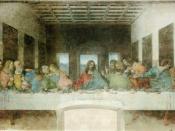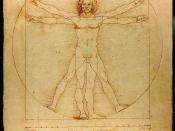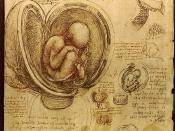Leonardo da Vinci's The Last Supper is a visual interpretation of an event that took place in all four gospels in the bible. What this painting specifically portrays is the next few seconds after Christ dropped the bombshell that one disciple would betray him before sunrise, and all twelve have reacted to the news with different degrees of horror, shock, awe, and anger. Leonardo da Vinci was an inventor and tried using new materials to paint The Last Supper. He thought he'd give using dry plaster a try. What he hadn't taken into account was that this method wasn't at all durable. The painted plaster began to flake off the wall almost immediately, and people have been attempting to restore it ever since.
The use of line and form in this painting guides your eyes directly to the center of the piece, which happens to be Jesus Christ, making this a closed composition with a linear perspective.
The uses of triangles in this painting lead you to concentrate on key points in the painting. The disciples are in groups of three, with Judas being recognized as the fourth disciple from the left grasping a bag (possibly with silver, as the story suggests). Jesus Christ himself is in a pose that resembles a triangle. A rhythm is used here with the repetition of triangles. I can't really tell much about da Vinci's use of chiaroscuro because of the amount of punishment and restoration that this painting has received over the years. What can be told is that da Vinci probably placed the head of Judas in a shadowy area for a good reason.
Leonardo da Vinci's The Last Supper has been hailed as the greatest example of one point perspective ever created.


